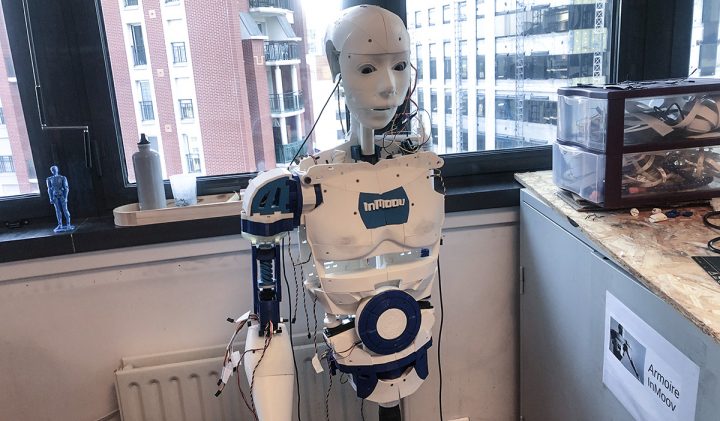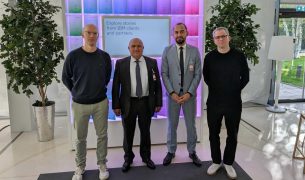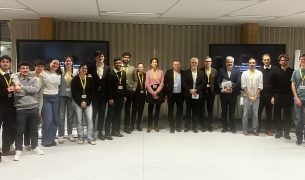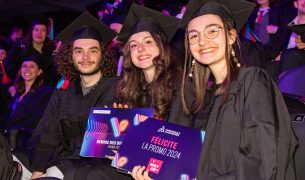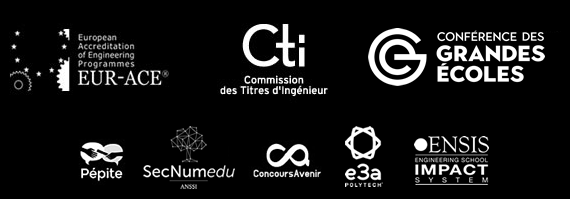Soumaya Sabry, a fifth-year student of ESILV and Ecole Polytechnique double-degree program, had her article on “People identity learning in HRI through an incremental multimodal approach” published as a part of IEEE International Conference on Robot & Human Interactive Communication.
Soumaya’s contribution was featured at the Cognitive Robotics for Interaction (CIRCE) Workshop, hosted at the 29th edition of International Conference on Robot & Human Interactive Communication. This event is organised each year by the Institute of Electrical and Electronics Engineers (IEEE), the world’s largest technical professional organisation for the advancement of technology.
A leading forum related to robot-human interactive communication
RO-MAN Conference is a leading forum set to present and discuss innovative results, the latest developments, as well as future perspectives relating to robot-human interactive communication.
The conference addresses topics related to Robot and Human Interactive Communication, which include theories, methodologies, technologies, empirical and experimental studies. Pieces of research related to the study of the robotic technology, psychology, cognitive science, artificial intelligence, human factors, ethics and policies, interaction-based robot design and other topics related to human-robot interaction are in the scope of the RO-MAN Conference.
As a part of the conference, the Cognitive Robotics for Interaction (CIRCE) Workshop provided a venue for HRI researchers, with a focus on cognition. The workshop provided an ideal setting to discuss open challenges in developing cognitive architectures for human-robot interaction, such as anticipation, adaptation (both emotional and motoric), dyadic and group interaction. It also tackled human inspiration and the technological implementation of cognitive architectures by means of, among others, computer vision and machine learning techniques.
The CIRCE workshop welcomed human-robot interaction researchers who are interested in interdisciplinary approaches and from a broad scope of disciplines such as robotics, neurosciences, social sciences, psychology and computer science.
Soumaya’s 5-year journey at ESILV, an opportunity to discover a love for robotics
Soumaya started her 5-year journey at ESILV in 2016. Her dream is to become a computer engineer. After completing three years of general engineering courses, she decided to continue the Research program at the De Vinci Research Center.
“Under the supervision of Mr Mohamed Ghassany (professor-researcher at ESILV), I started to study the subject “People Identity Learning”. Then, I had the chance to continue my research as an intern at the CHArt lab, supervised by both Mr. Ghassany and Mr. Anzalone (professor-researcher at the University of Paris 8). At the end of my internship, I published a scientific article during a Workshop organized as part of the IEEE RO-MAN 2020 conference.” (Soumaya Sabry, 5-th year student at ESILV)
“Currently, in my last year of studies, I was chosen among five students to join the Data-Science master’s double-degree program offered by ESILV and Institut Polytechnique de Paris (IP Paris). At the end of my studies, my objective would be to do a thesis oriented towards e-health combined with robotics.”
From the start of her studies, Soumaya was passionate about robotics. “Robots have developed considerably in previous years and are increasingly present in our society. They are programmed or controlled by machine learning, an area that caught my interest. My subject proposed an approach to give robots cognitive abilities to act, personalize and adapt their behaviours to the human partner.”
In recent years, research efforts have focused on providing robots with the appropriate cognitive abilities to act autonomously safely and intelligently in real-world scenarios. An example of such systems is human-robot interaction (HRI), where humans are individuals and want to be treated likewise. Therefore, robots must be able to personalize and adapt their behaviours to each human partner. To achieve this goal, scientists have to create robots which must develop a reliable characterization of the identity of each human partner.
“My research objective is to create a robotic system capable of learning the identity of humans through an incremental multimodal approach. The multimodal approach is a model that receives data from multiple sources. In our case, we choose two types of data: the voice and the face of humans, as a signature to identify them. The “incremental” part means that the system will not remain frozen in time; the robot will be able to learn over time and develop.”
The experiment was performed on a sample of videos that mimic an HRI scenario. The results show how the multimodal system, combining voice and face, outperforms the performance of single modalities, recovering each of their failures.
“The recognition capacity of the system, applied to these videos, was high, but these videos have limitations. Despite such limits, this work shows the potential of the proposed approach used to the identity learning problem. Future pieces of research will focus on developing and evaluating a possible implementation on a real robot, in real-world scenarios.”
Want to know more about ESILV’s master’s programme in computer science? Visit ESILV’s website.









